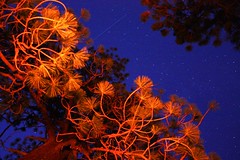 California orange bellied newt (Taricha torosa).
California orange bellied newt (Taricha torosa).
One of the great indicators of seasonal change in the Santa Ynez Range of Santa Barbara is the arrival of orange bellied newts to mountain streams. They don’t always live in water.
Newts spend most of their lives on land crawling through the forest or avoiding desiccation holed up in subterranean shelters waiting out long dry summers. The first three years of a young newt’s life can be spent entirely on land.

Following winter rains when the creeks run anew, newts migrate from their terrestrial shelters to mate in the seasonal flush of runoff, temporarily inhabiting the streams before returning to land. They have been known to trek up to five miles to reach their breeding sites.
To accomplish this migratory feat, Kate Marianchild writes in her book, “Secrets of Oak Woodlands,” it is thought that a newt “apparently relies on magnetic iron oxide crystals lodged in her brain to sense the earth’s geomagnetic field and acquire an internal ‘map.'”
Along with an ability to recognize landmarks and smell the familiar scents of riparian habitat, newts are thought to have something like a “‘celestial compass’ that uses special photoreceptors.” These receptors are sensitive to “patterns created by the polarization of sunlight, moonlight, and starlight when it hits the earth’s atmosphere.”
Marianchild writes of newts taken twenty-eight miles from a stream and when placed in a tank of water they immediately turned to face their natal waters.

Newts have thin permeable skin that allows oxygen to be absorbed directly from the water into their bloodstream and extends the amount of time they can remain underwater, which is about twenty to thirty minutes.
Taricha torosa are extremely toxic and can kill a person if eaten. They are loaded with tetrodotoxin, which is “one of the most powerful neurotoxins known, it is about 1200 times more toxic to humans than cyanide and it has no known antidote.” (National Center for Biotechnology Information, U.S. National Library of Medicine)
People that have been poisoned with tetrodotoxin from pufferfish and other creatures have suffered such things as nausea, abdominal cramping, diarrhea, vomiting, vertigo, slurred speech, inability to speak, difficulty swallowing, blurred vision, a burning or prickling sensation all over the body, ascending paralysis of the limbs, altered consciousness with unreactive dilated pupils, respiratory paralysis and death in less then twenty minutes.
One story tells of a few guys camping and while making coffee one unknowingly scooped up a newt in the pot while getting water from a stream. All three men were found dead with no signs of anything having happened but for the boiled newt in the coffee pot.





















Hello Jack, I enjoy your blog. Thanks.
Good to hear from you. Thanks.
Superb shots! 🙂
Thanks. Not bad for an iPhone.
Who knew a newt could be so interesting, but it turns out they are. Thanks for the post.
Very interesting post from the ‘iron oxide crystals’ to the toxicity. The sea turtle hatchlings, as you know, have some type of GPS system as well…
I will remember to always check the water from stream-filled pots! Amazing but tragic story.
So it looks like you can’t adsorb the tetrodotoxin through the skin….good thing!
Yeah. Funny I’ve been playing with these things since childhood and even passed that interest onto my kids, but had never known how deadly they can be.
Note to self: check coffee pot before boiling water for morning Joe.